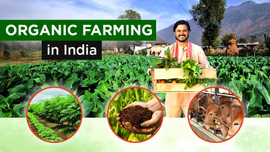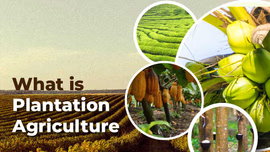Capsicum Farming in India: A Complete Guide to its Cultivation Process

Capsicum, also known as bell pepper or Shimla Mirch, is one of the most popular vegetable crops in India, which is grown under protected conditions. It is rich in vitamins A, C and minerals like potassium. Farmers in India are also becoming interested in capsicum cultivation, as it yields better returns compared to other traditional crops. In today’s blog, we will explore everything related to capsicum cultivation from soil & climate to harvest & yield.
Table of Contents
- An Introduction to Capsicum Farming
- Which are the Popular Capsicum Varieties in India?
- What is the Capsicum Cultivation Method?
An Introduction to Capsicum Farming
The name ‘Capsicum’ is derived from the Greek word ‘kapto’, meaning “to bite” or “to swallow”. Its scientific name is Capsicum annuum, and it belongs to the family Solanaceae. It comes in various colours, shapes and sizes, which are very popular in different dishes in India. Where green capsicum is slightly bitter or “grassy” taste and crunchier, and is used in salads and many other dishes, on the other hand, yellow and red bell peppers are sweeter due to their greater ripeness. They are perfect for salads, pasta, and noodles like dishes. A single medium green capsicum gives 8% of the recommended daily allowance of Vitamin A, 180% of Vitamin C, 2% of calcium and 2% of iron.
Indian farmers are coming more into capsicum cultivation due to its higher demand, better returns and principal export value. It is grown under a partially controlled environment in polyhouses or greenhouses with a proper nursery setup, which allows for year-round production.
Which are the Popular Capsicum Varieties in India?
- Arka Basant
- Arka Gaurav
- Arka Mohini
- Green Gold
- Bharath
What is the Capsicum Cultivation Method?
Soil & climate requirements, nursery preparation, land preparation, & transplanting are some of the steps in capsicum cultivation. Let’s understand the complete cultivation process in detail.
Soil & Climate Requirements
Capsicum grows best in well drained loamy soil which is rich in organic matter. The pH of the soil ranges between 6 and 7 is ideal for capsicum. It usually requires a dry climate and moderate temperature ranging between 20 to 25°C.
Nursery Preparation
Prepare the nursery by selecting high-quality seeds and transplant them to the actual field. The best time for sowing capsicum is September to February. The seed rate of the capsicum varieties should be 1.25 kg/ha. For hybrid varieties, the recommended seed rate is 200 g/ha. Seeds should be treated with Carbendazim at 2 g/kg of seed and sown in lines across the bed at a spacing of 2.5 cm. Then, they should be covered with topsoil and paddy straw. Watering should be done daily using a watering can. Fungicides are applied to prevent fungal infections in crops. After a specific time, transfer seedlings one by one under a shade net for further growth.
Land Preparation & Transplanting
To prepare the land, ploughing should be done properly. Ridges and furrows need to be constructed 45 or 60 cm apart. Transplant 40-45 days old seedlings at 30 cm spacing.
Irrigation & Fertilizer Management
Irrigation should be done in 7 to 10 days depending upon the crop growth. As capsicum crops are a sensitive crop to water, drip irrigation and fertigation needs to be done. Apply FYM 25 t/ha and NPK 40:60:30 kg /ha with super phosphate. Apply 2 kg/ha of Azospirillum and 2 kg/ha of Phosphobacteria by mixing with 20 kg of FYM. After 7 days, transplant the seedlings again in place of dead seedlings.
Intercultural Operations
Hoeing and weeding should be done once on the 30th day and the plants are earthed up. Spray 1.25 ppm Triacontanol (12.5 mg /10 l of water) from 20th till 80th day with an interval of 20 days in between after transplanting. Spray NAA 10 ppm (10 mg/l of water) on 60 and 90 days after planting.
Pests & Disease Management
Thrips, Aphids, Powdery mildew, etc. are some of the major pests and diseases of capsicum. Let’s have a look at all of them below with the control measures.
- Thrips: Spray Spinosad (Tracer) (1 ml/L) or Shakti 10 (1ml/L) or Ulala (0.5ml/L).
- Aphids: Chess (1g/L) or Permit (2g/L) or Sarpanch (2ml/L) or Ulala (1ml/L).
- Powdery Mildew: Wettable sulphur(2g/L) or penconazole(0.5ml/L) or flusilazole (0.5ml/L).
- Phytophthora: Copper hydroxy chloride (3g/L) or Ridomil (2g/L) or azoxystrobin (0.5ml/L).
- Dieback and Fruit Rot: Spray Mancozeb @ 2g /l
Harvest & Yield
Harvesting should be done based on the different stages of coloured capsicum as given below:
- Green Capsicum: 55 to 60 days
- Yellow Capsicum: 70 to 80 days
- Red Capsicum: 80 to 90 days
The average yield of capsicum is 15 tonnes/ha in 150-160 days.
Conclusion
Capsicum cultivation has been increasing due to its high demand and better returns. For capsicum farming in a controlled polyhouse, the government provides subsidies to the farmers. In the absence of a subsidy, the BCR can increase to 1.18. However, if a subsidy is provided, the total BCR can reach 1.85 and beyond.
Frequently Asked Questions On Capsicum Farming in India: A Complete Guide to its Cultivation Process
1. Is Capsicum Farming Profitable?
Yes, capsicum farming is a highly profitable farming venture, especially when grown under protected conditions, which gives year-round production, better quality, and higher yields.
2. How long does it take to grow capsicum?
A capsicum generally requires 60 to 90 days for the optimal growth.
3. How many capsicum plants are in 1 acre?
A total of 10,000 to 14,000 capsicum plants can be grown per acre.
4. What is the best capsicum growing season in India?
Capsicum farming can be done all year round under controlled conditions. However, the best season is from September to February.
5. Can capsicum grow in direct sunlight?
Yes, capsicum can be grown in direct sunlight to produce good quality and nourished fruit.
6. What's the best fertilizer for capsicum plants?
Application of FYM 25 t/ha and NPK 40:60:30 kg /ha with super phosphate is considered as the best fertilizer application for the capsicum plants.


Related Blogs












